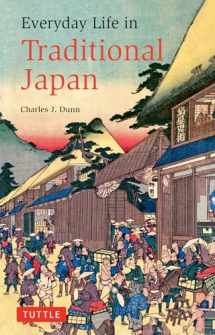
Everyday Life in Traditional Japan (Tuttle Classics)
ISBN-13:
9784805310052
ISBN-10:
4805310057
Edition:
Illustrated
Author:
Charles J. Dunn
Publication date:
2008
Publisher:
Tuttle Publishing
Format:
Paperback
208 pages
Category:
Customs & Traditions
,
Social Sciences
,
Cultural
,
Anthropology
FREE US shipping
Book details
ISBN-13:
9784805310052
ISBN-10:
4805310057
Edition:
Illustrated
Author:
Charles J. Dunn
Publication date:
2008
Publisher:
Tuttle Publishing
Format:
Paperback
208 pages
Category:
Customs & Traditions
,
Social Sciences
,
Cultural
,
Anthropology
Summary
Everyday Life in Traditional Japan (Tuttle Classics) (ISBN-13: 9784805310052 and ISBN-10: 4805310057), written by authors
Charles J. Dunn, was published by Tuttle Publishing in 2008.
With an overall rating of 4.5 stars, it's a notable title among other
Customs & Traditions
(Social Sciences, Cultural, Anthropology) books. You can easily purchase or rent Everyday Life in Traditional Japan (Tuttle Classics) (Paperback) from BooksRun,
along with many other new and used
Customs & Traditions
books
and textbooks.
And, if you're looking to sell your copy, our current buyback offer is $0.37.
Description
Everyday Life in Traditional Japan paints a vivid portrait of Tokugawa Japan, a time when contact with the outside world was deliberately avoided, and the daily life of the different classes consolidated the traditions that shaped modern Japan.
With detailed descriptions and over 100 illustrations, authentic samurai, farmers, craftsmen, merchants, courtiers, priests, entertainers and outcasts come to life in this magnificently illustrated portrait of a colorful society. Most works of Japanese history fail to provide enough details about the lives of the people who lived during the time. The level of detail in Everyday Life in Traditional Japan allows for a more informed picture of the history of Japan.
In fascinating detail, Charles J. Dunn describes how each class lived: their food, clothing, and houses; their beliefs and their fears. At the same time, he takes account of certain important groups that fell outside the formal class structure, such as the courtiers in the emperor's palace at Kyoto, the Shinto and Buddhist priests, and the other extreme, the actors and the outcasts. He concludes with a lively account of everyday life in the capital city of Edo, the present–day Tokyo.
With detailed descriptions and over 100 illustrations, authentic samurai, farmers, craftsmen, merchants, courtiers, priests, entertainers and outcasts come to life in this magnificently illustrated portrait of a colorful society. Most works of Japanese history fail to provide enough details about the lives of the people who lived during the time. The level of detail in Everyday Life in Traditional Japan allows for a more informed picture of the history of Japan.
In fascinating detail, Charles J. Dunn describes how each class lived: their food, clothing, and houses; their beliefs and their fears. At the same time, he takes account of certain important groups that fell outside the formal class structure, such as the courtiers in the emperor's palace at Kyoto, the Shinto and Buddhist priests, and the other extreme, the actors and the outcasts. He concludes with a lively account of everyday life in the capital city of Edo, the present–day Tokyo.


We would LOVE it if you could help us and other readers by reviewing the book
Book review

Congratulations! We have received your book review.
{user}
{createdAt}
by {truncated_author}


